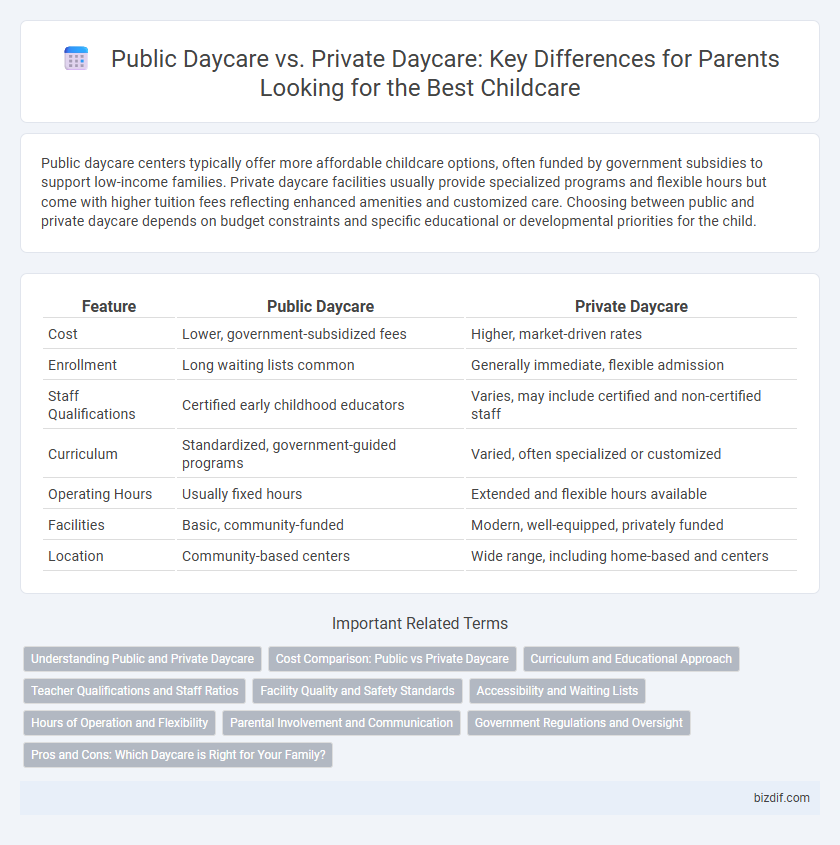Public daycare centers typically offer more affordable childcare options, often funded by government subsidies to support low-income families. Private daycare facilities usually provide specialized programs and flexible hours but come with higher tuition fees reflecting enhanced amenities and customized care. Choosing between public and private daycare depends on budget constraints and specific educational or developmental priorities for the child.
Table of Comparison
| Feature | Public Daycare | Private Daycare |
|---|---|---|
| Cost | Lower, government-subsidized fees | Higher, market-driven rates |
| Enrollment | Long waiting lists common | Generally immediate, flexible admission |
| Staff Qualifications | Certified early childhood educators | Varies, may include certified and non-certified staff |
| Curriculum | Standardized, government-guided programs | Varied, often specialized or customized |
| Operating Hours | Usually fixed hours | Extended and flexible hours available |
| Facilities | Basic, community-funded | Modern, well-equipped, privately funded |
| Location | Community-based centers | Wide range, including home-based and centers |
Understanding Public and Private Daycare
Public daycare centers are typically funded and regulated by government agencies, ensuring affordable access and standardized quality of care for families. Private daycare facilities operate independently, often offering specialized programs and flexible hours but usually at a higher cost. Choosing between public and private daycare depends on factors such as budget, desired curriculum, and availability in the local community.
Cost Comparison: Public vs Private Daycare
Public daycare centers typically offer lower enrollment fees compared to private daycares, with average monthly costs ranging from $400 to $900 depending on location and subsidies. Private daycare facilities often charge between $1,000 and $2,000 per month, reflecting higher operational costs and exclusive programs. Parents considering daycare options should evaluate financial assistance programs and the value of additional services when comparing overall expenses.
Curriculum and Educational Approach
Public daycare centers often follow state-mandated curricula designed to meet standardized educational benchmarks, emphasizing inclusive practices and developmental milestones aligned with early childhood education frameworks. Private daycare facilities typically offer specialized or enriched programs, incorporating diverse pedagogical approaches such as Montessori, Reggio Emilia, or STEAM-focused curricula tailored to individual learning styles. Parental choice between public and private daycare can hinge on preferences for curriculum flexibility, educational philosophy, and resource availability within each setting.
Teacher Qualifications and Staff Ratios
Public daycare centers often employ teachers with state-mandated certifications and maintain lower student-to-teacher ratios, ensuring personalized attention and adherence to educational standards. Private daycare facilities may vary widely in teacher qualifications, with some offering specialized training in early childhood education but often operating with higher staff-to-child ratios due to budget constraints. Research shows that lower staff ratios and highly qualified teachers significantly improve developmental outcomes and safety in early childhood settings.
Facility Quality and Safety Standards
Private daycares often invest more in advanced facility quality, featuring modern play equipment and enhanced childproofing measures, whereas public daycares adhere strictly to government-mandated safety standards ensuring baseline protection. Public daycare facilities typically comply with state regulations that guarantee minimum requirements for cleanliness, child-to-staff ratios, and emergency preparedness, while private centers may exceed these standards through additional certifications and regular third-party inspections. Choosing between public and private daycare depends on evaluating how each facility balances quality enhancements with adherence to rigorous safety protocols.
Accessibility and Waiting Lists
Public daycare centers often provide more affordable options but face longer waiting lists due to limited capacity and high demand in densely populated areas. Private daycare facilities tend to offer greater accessibility and flexibility with shorter waiting periods, although their higher fees may limit availability for some families. Parents seeking immediate enrollment frequently find private daycare centers more accessible, while public programs require early application and patience due to extensive waiting lists.
Hours of Operation and Flexibility
Public daycare centers generally offer standard operating hours aligned with typical work schedules, often from 8 AM to 5 PM, with limited flexibility for early drop-off or late pick-up. Private daycare facilities frequently provide extended hours, including early mornings, evenings, and weekend care, catering to parents with non-traditional work hours. Flexibility in private daycares allows families to customize schedules more easily, meeting diverse childcare needs beyond the rigid frameworks of public daycare hours.
Parental Involvement and Communication
Public daycare centers often encourage active parental involvement through structured communication channels like regular meetings, newsletters, and parent-teacher conferences, fostering transparency and collaboration. Private daycare facilities typically offer more personalized communication methods, such as daily reports and direct digital messaging, enabling tailored updates about each child's progress. Both models emphasize the importance of parental engagement but differ in their approaches to facilitating ongoing dialogue and involvement.
Government Regulations and Oversight
Public daycare centers adhere to stringent government regulations and oversight, ensuring standardized health, safety, and educational guidelines are met consistently. Private daycare providers may follow similar regulations but often vary in the extent of compliance and frequency of government inspections. Government oversight aims to protect child welfare in both settings, but public centers typically benefit from more rigorous monitoring and accountability measures.
Pros and Cons: Which Daycare is Right for Your Family?
Public daycare offers affordable tuition rates and often benefits from state funding, ensuring regulatory compliance and access to licensed early childhood educators. Private daycare centers provide more flexible hours, specialized programs, and lower child-to-teacher ratios but usually come with higher costs that may not fit every family's budget. Families should weigh accessibility, cost, educational quality, and individual child needs to determine the most suitable daycare option.
Public daycare vs Private daycare Infographic

 bizdif.com
bizdif.com